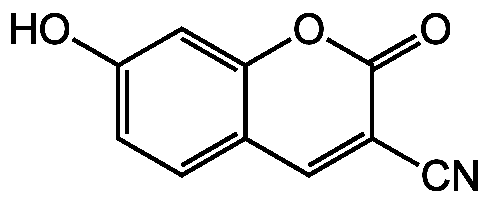3-Cyanoumbelliferone
| Code | Size | Price |
|---|
| CDX-C0007-M100 | 100 mg | £108.00 |
Quantity:
| CDX-C0007-G001 | 1 g | £242.00 |
Quantity:
| CDX-C0007-G005 | 5 g | £706.00 |
Quantity:
Prices exclude any Taxes / VAT
Overview
Regulatory Status: RUO
Shipping:
Ambient
Storage:
+4 °C
Images
Documents
Further Information
Appearance:
Light red powder.
CAS:
19088-73-4
EClass:
32160000
Form (Short):
liquid
GHS Symbol:
GHS07
Handling Advice:
Protect from light and moisture.
Hazards:
H302, H312, H315, H319, H332, H335
InChi:
InChI=1S/C10H5NO3/c11-5-7-3-6-1-2-8(12)4-9(6)14-10(7)13/h1-4,12H
InChiKey:
IJQYTHQDUDCJEQ-UHFFFAOYSA-N
Long Description:
Chemical. CAS: 19088-73-4. Formula: C10H5NO3. MW: 187.15. Synthetic. Phenolic dyes with high pKas - such as 7-hydroxycoumarin (often called umbelliferone) and the more common 7-hydroxy-4-methylcoumarin - are not fully deprotonated and therefore not fully fluorescent unless the pH of the reaction mixture is raised to above pH ~10. Thus, substrates derived from these fluorophores are seldom used for continuous measurement of enzymatic activity in solution or live cells. The similar 3-cyano-7-hydroxycoumarin and 6,8-difluoro-7-hydroxy-4-methylcoumarin have lower pKas, making them suitable for a broader range of applications. Moreover, the -trifluoromethylumbelliferone product has longer-wavelength spectra and stronger absorbance than -methylumbelliferone. Ether, ester and phosphate substrates derived from these phenolic dyes may be fluorescent but invariably exhibit shorter-wavelength absorption and emission spectra.
MDL:
MFCD00037480
Molecular Formula:
C10H5NO3
Molecular Weight:
187.15
Package Type:
Vial
Precautions:
P261, P280, P305, P351, P338
Product Description:
Phenolic dyes with high pKas - such as 7-hydroxycoumarin (often called umbelliferone) and the more common 7-hydroxy-4-methylcoumarin - are not fully deprotonated and therefore not fully fluorescent unless the pH of the reaction mixture is raised to above pH ~10. Thus, substrates derived from these fluorophores are seldom used for continuous measurement of enzymatic activity in solution or live cells. The similar 3-cyano-7-hydroxycoumarin and 6,8-difluoro-7-hydroxy-4-methylcoumarin have lower pKas, making them suitable for a broader range of applications. Moreover, the -trifluoromethylumbelliferone product has longer-wavelength spectra and stronger absorbance than -methylumbelliferone. Ether, ester and phosphate substrates derived from these phenolic dyes may be fluorescent but invariably exhibit shorter-wavelength absorption and emission spectra.
Purity:
>98% (TLC)
Signal word:
Warning
SMILES:
OC1=CC=C2C=C(C#N)C(=O)OC2=C1
Solubility Chemicals:
Soluble in alcohols or DMF.
Source / Host:
Synthetic.
Transportation:
Non-hazardous
UNSPSC Category:
Fluorescent Reagents
UNSPSC Number:
41105331
Use & Stability:
Stable for at least 2 years after receipt when stored at +4°C.
References
(1) I.N. White et al.; Anal. Biochem. 172(2), 304 (1988)



